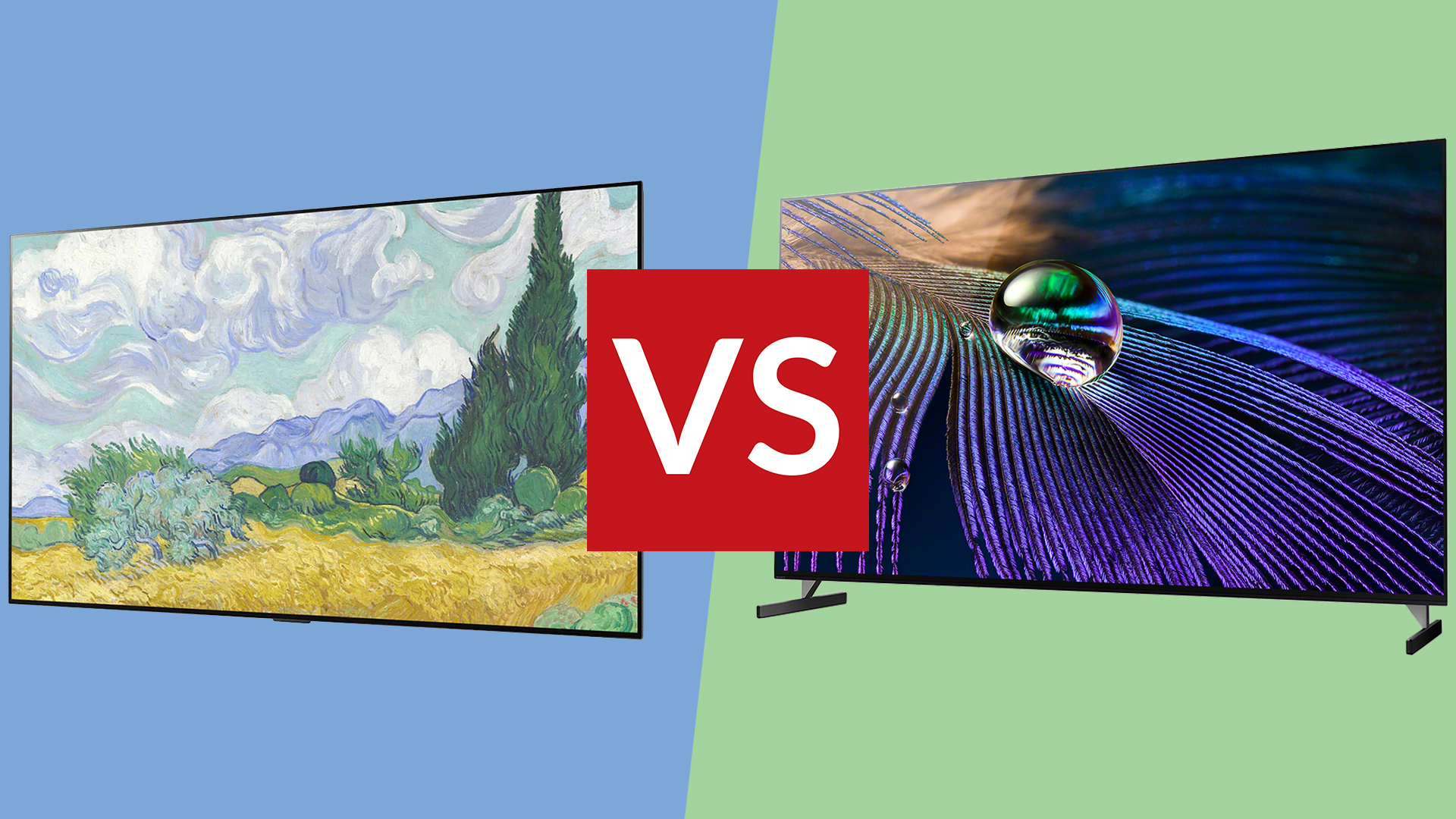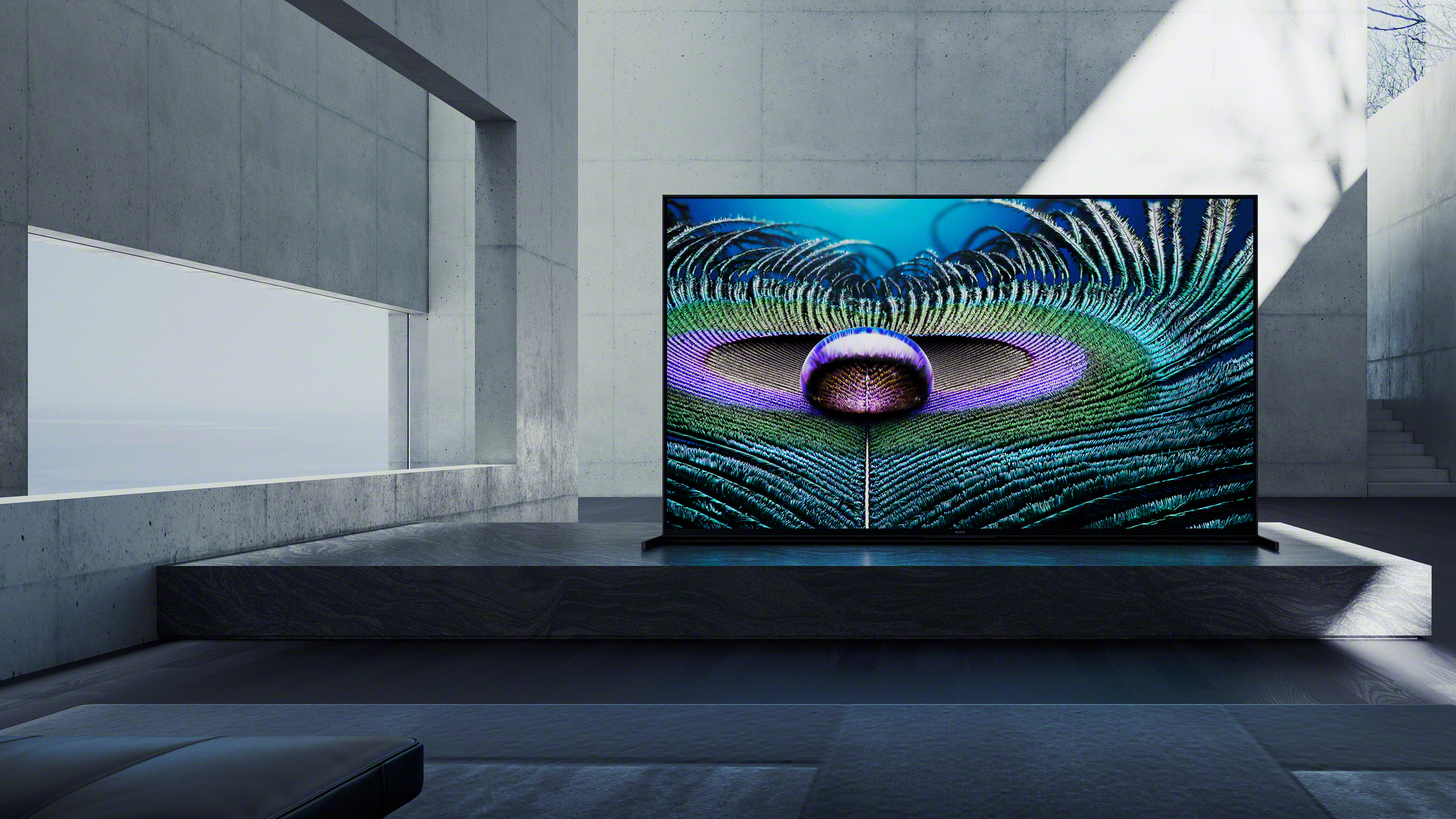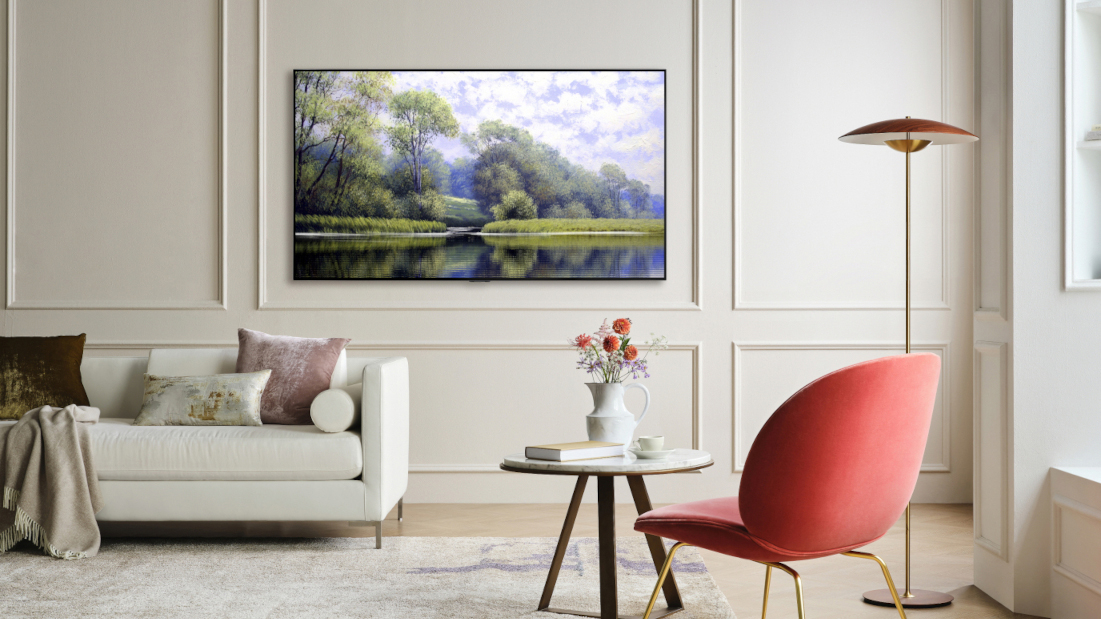
If you're looking at the best OLED TVs of 2021, you'll definitely be wondering about the LG G1 vs Sony A90J, because these are the elite 4K OLED TVs from two makers of many of the best TVs in the business.
LG’s Gallery series G1 is the captain of LG’s 2021 OLED squad. Distinguished by a hang-on-the wall form factor that interior designers will fawn over, it also showcases LG’s new Evo higher-brightness panel. We're already got our full LG G1 review, and it's a knockout.
The G1 also features LG’s latest Gen 4 Alpha 9 picture engine and an all new webOS smart platform, which looks uncannily like Google TV… which just so happens makes its debut on this Sony set.
Sony’s Master Series A90J is as photogenic as the G1, but doesn’t deprive you of the basics – unlike the LG G1, it actually comes with feet. It’s also wafer thin, and like the G1 aims for higher brightness levels than previous models.
Let's see how the two models compare overall.
LG G1 vs Sony A90J: Price
The Sony A90J is considerably more expensive than its LG rival, though if you have to buy feet or a stand of the LG, that might make up a bit of the difference…
The LG G1 comes in 55-, 65- and 77-inch screen sizes (OLED55G1, OLED65G1, OLED77G1), priced at £1,999, £2,999 and £4,799 respectively
Get all the latest news, reviews, deals and buying guides on gorgeous tech, home and active products from the T3 experts
In the US, the same models sell for $1,999, $2,999 and $4,799.
In Australia, the LG G1 line-up retail for AU$3,799, AU$5,299 and AU$9,999.
Sony’s A90J range comprises 55-, 65-, and 83-inch models (XR-55A90J, XR-65A90J, XR-83A90J), priced at £2,699, £3499 and TBA respectively.
In Australia and the US, only 65- and 83-inch models are incoming, with prices yet to be announced.
LG G1 vs Sony A90J: Design and connectivity
The LG G1 is called a Gallery screen for a reason: it’s designed to be hung on the wall like a magnificent work of AV art. It doesn’t even come with a pedestal or feet in the box. If you want to keep the panel on terra firma, you’ll need to invest in optional boots or the brand’s new designer Gallery stand.
A uniform depth of 2cm means you can achieve a flush fit when wall mounted, thanks partly to a custom mounting bracket that is in the box. Viewed square on, the G1 is predictably minimal, with a thin black bezel. Build quality and finish are top notch.
The Sony is much thinner, at least for the panel, but bulges to 4cm near the middle to accommodate electronics and connectivity. It adopts a ‘One-Slate’ minimal finish.
More importantly, it comes with feet. There’s a choice of height settings. One brings the panel virtually flush with your furniture, the other lifts the display, creating room for one of the best soundbars, smartly.
The Sony A90J ships with a slick, metallic finish backlight remote, while the LG G1 offers a smaller version of its Magic Remote cursor wand.
There’s a significant difference between the two TVs when it comes to connectivity. The G1 has four HDMIs, all of which are HDMI 2.1 and support 4K 120Hz, able to cope with the highest frame output from a PS5 or Xbox Series X. The G1 is also eARC enabled, for lossless audio from screen to connected soundbar or AV system.
Gaming support covers VRR (Variable Refresh rate), ALLM (Auto Low Latency Mode) and Nvidia G-Sync. There’s also USB, a digital audio optical output, Wi-Fi and Bluetooth.
The Sony A90J also offers four HDMI inputs, one with eARC, but only two are HDMI 2.1 and 4K 120Hz ready. There is support for Variable Refresh Rate promised via firmware at some point in the future (though last year's TVs are still waiting for that upgrade), and Auto Low Latency compliance. We also get a trio of USBs, Ethernet, a digital optical output, Wi-Fi and Bluetooth.
The A90J uniquely can also be wired to act as a centre speaker in a multichannel home cinema system.

The Sony A90J is a great-looking TV.
LG G1 vs Sony A90J: Picture and sound performance
The G1 puts its new Evo panel to good use, with stunning images. Coupled to the LG’s 4th-gen Alpha 9 image processor, it’s very impressive.
HDR support covers regular HDR10, HLG and Dolby Vision with IQ (via the Dolby Vision Cinema Home preset), which improves HDR contrast in brighter room conditions. There’s also Filmmaker Mode for a purist take on movie-watching.
Audio-wise, the G1 is entirely serviceable. There’s a Dolby Atmos decoder onboard, although don’t expect much in the way of immersive audio.
The Sony A90J similarly pulls out all the stops for visuals. It features an upgraded AI processing engine with Cognitive Intelligence, for more lifelike imagery. The big idea is that the Cognitive Processor XR processor replicates the way we see and hear, and its processing is focused around that. The screen is divided into zones so that the processor can analyse and enhance the focal point, making the best use of its power.
The A90J also uses a new OLED panel, but it’s unclear if employs the same technology as LG’s Evo panel. Sony isn’t saying. HDR support covers HDR10, HLG and Dolby Vision.
Neither Sony nor LG are compatible with HDR10+. The Sony set is certified IMAX Enhanced and has a Netflix Calibrated viewing mode.
When it comes to audio performance, Sony takes a clear lead with Acoustic Surface Audio+ technology. This uses transducers to vibrate the panel itself to create sound, aided with rear-mounted woofers – it's as effective as a soundbar, which is partly why Sony can justify the higher price.

The LG G1 is designed for wall-mounting.
LG G1 vs Sony A90J: Smart TV
Both LG and Sony have given their smart platforms a face lift this year.
Sony has moved to Google TV for 2021, which is the same as Android TV in many ways, but more user friendly. Expect a comprehensive selection of streaming platforms, including Netflix, Amazon Prime Video and Disney+.
The A90J also introduces Bravia Core, Sony’s own high quality movie streaming service. This offers new PPV and classic titles, and uses innovative Pure Stream technology, to achieve (theoretically) near lossless Ultra HD Blu-ray quality over the internet, without requiring totally ridiculous connections.
For UK buyers, Catch-Up TV needs are served by YouView, as there’s no support for Freeview Play.
Thankfully Freeview Play is back on the LG G1 (after spending 2020 divorced from the brand). We also get our first look at the all-new webOS v6.0. Unlike its predecessor, this webOS upgrade has a full screen display, ostensibly to offer more content recommendations.
There’s a Trending Now bar which mixes live TV with OTT services, including Netflix, Prime Video, Apple TV+ , Disney+, Rakuten TV, Now TV, AppleTV+, YouTube, Hulu, Vudu and Twitch.
LG G1 vs Sony A90J: Verdict
The Sony A90J and LG G1 are both class-leading OLED TVs, offering a significant jump in specification and performance over their 2021 counterparts.
When it comes to connectivity, LG clinches top spot, as all four HDMI inputs are v2.1 and offer 4K 120Hz support. Sony’s decision to enable only two HDMIs for 4K 120Hz is going to limit some high-end gamers.
Both smart platforms, Google TV and webOS, are slick, but suffer from first generation execution, so there’s not much to choose between them
When it comes to picture performance, both LG and Sony use class-leading smart AI processing to squeeze ever more from source material. The Sony takes the audio prize though, its innovative Acoustic Surface Audio+ is always a better bet than conventional downward firing speakers.
Ultimately though, your buying choice will boil down to form factor. If you want a TV designed for wall mounting, the LG G1 is the screen to go for. It’s perfect for the job. The Sony is the more conventional option – but it comes with a price premium.
For over 25 years, Steve has been casting his keen eyes and ears over the best that the world of TV and audio has to offer. He was the creator of Home Cinema Choice magazine, and contributes to huge range of technology, home and music titles along with T3, including TechRadar, Louder, Ideal Home, the i newspaper, and more.

